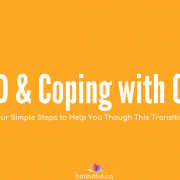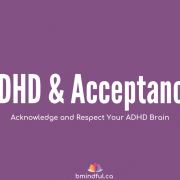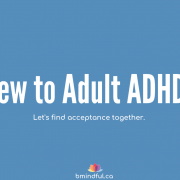Supervision and consultation services are available for qualifying registered psychotherapists (RPQ) and registered psychotherapists (RP) required to practice under clinical supervision. Services are offered to CRPO members in Ottawa and across Ontario. Clinical supervision focuses on case conceptualization, psychotherapy skills, professional development, and self-care. For more information please contact Sonia Tanguay RP at sonia@bmindful.ca.
Prolonged chronic stress can have longstanding effects on the nervous system’s ability to self-regulate. What does self-regulation mean? It means being able to get back from a state of hyperactivation or hypoactivation to a functional state. When we are in a state of hyperactivation the body reacts to stress by sweating, being reactive, piercingly hyperfocusing, restlessness, and aggressivity. We can describe this state as the fight/flight response. In contrast, in a state of hypoactivation the body “freezes” and may experience feelings of being lethargic, passive, frozen, slow and withdrawn, unable to focus, numb or cold. When we are in a functional state we may notice calmness, social connectedness, curiosity, empathy, and openness. We have a greater ability to be connected with ourselves and the world around us. Physiologically, digestion, resistance to infection, circulation, immune responses, and our ability to connect are improved.
One way to return to a state of homeostasis and balance is through the use of movement. The benefit of movement can imprint onto the nervous system to release and soothe. The central nervous system is comprised of the sympathetic and parasympathetic systems. Part of the parasympathetic nervous system is the vagus nerve. It is the master nerve that stems from the lower part of the skull, clusters around the chest and then in the gut area. Movement can increase the vagal tone that activates the parasympathetic system and the body’s ability to down-regulate. To get back to that rest and digest mode. So what movement can soothe your system:
- Gentle neck stretches from left to right
- Lowering your chin to your chest
- While seated lengthening your spine to gently twist the torso to each side. Think of the chair seated twist yoga pose.
A well-known statement used in somatic psychology is to move to thaw your freeze. Movement can allow us to release long-held tension. When we freeze, we tend to habitually hold our breath, sit passively, disconnect from our surroundings, and most commonly distract ourselves with technology. Depending on daily stressors the body will shift from one state to another. We are not trying to keep ourselves from moving to the fight, flight, freeze zone but rather increasing our range of function and tolerating feelings of discomfort. When we find ourselves outside of the rest and functional zone we can use movement to increase our ability to get back to it. Take time in the next week to pay attention to what your body is telling you. Notice shifts in your internal state by listening to your body with intention, attention and the action of movement.
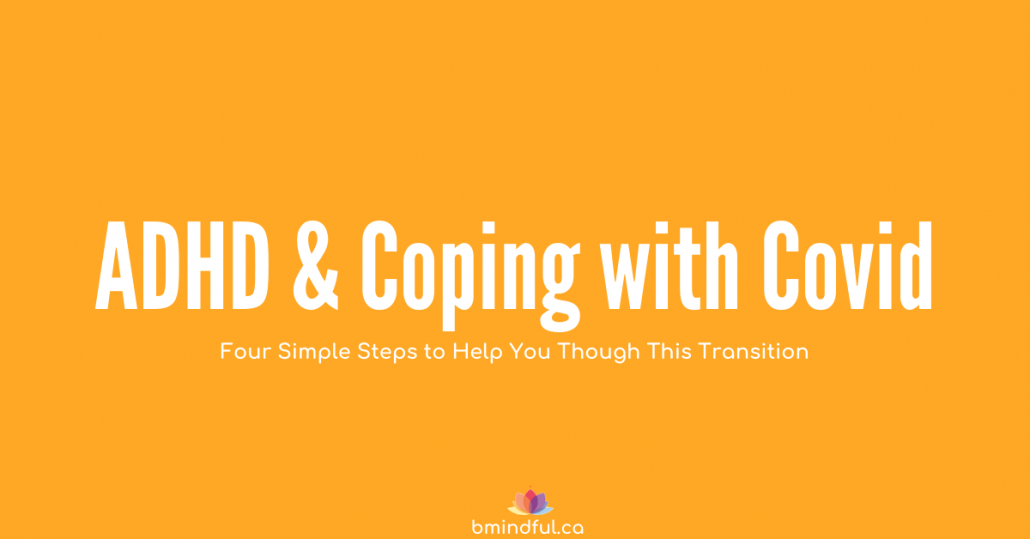 People with ADHD brains tend to have a hard time with big life changes. In fact, we are all (neuro and non-neurotypical brains) having a hard time adjusting to lifestyle and emotional changes due to COVID.
People with ADHD brains tend to have a hard time with big life changes. In fact, we are all (neuro and non-neurotypical brains) having a hard time adjusting to lifestyle and emotional changes due to COVID.
As a result, strategies previously used to compensate for known or unknown challenges may no longer work (or be available) in the same way. Right now there is limited access to in-person social networks and physical activity outlets. As well as, huge changes in the settings and time for work and family life. Not to mention, the added stressors of job security, food purchasing and family well-being. This experience can come with a landslide of feelings such as overwhelm, anxiety, sadness, or frustration.
We want to share some simple tips to help you get through this difficult time:
Acknowledge that transitions are hard!
We are experiencing daily transitions in terms of what work, family life and leisure time looks like. It is normal to have difficult days. However, remember feelings do not last forever; they come and go like clouds in the sky. So if a day is going rough let yourself off the hook and be kind to yourself. Be in the moment with the difficult feelings. Say to yourself “this is really hard right now.” Try not to exaggerate the feelings by thinking it will always be this way or that you won’t get through it. Tomorrow is another day, with different experiences, and new moments to discover.
You are not alone in this struggle.
This is a difficult time. It is challenging figuring out a new schedule and routine. There are many worries about the future and those in our community. These are thoughts and feelings we share in. When you are having a difficult moment recognize our shared common humanity. “I am not alone in this, others are feeling this way, we are all just trying our best.” This can help you move from a place of isolation to one of connectedness.
Let things go & connect with what matters.
So your home might be messier than usual, you may be less productive, or you may be less active. It is all okay. Ask yourself can I let this go for now? Is this thought/ pressure working for me, helping me be the person deep in my heart? What sort of person do I want to be as I go through this? What do I really want to stand for in the face of this crisis? How do I want treat myself and others? What can I do that would be kind for myself?
F.A.CE. C.O.VI.D
Russ Harris has recently shared an amazing acronym F.A.CE. C.O.VI.D and video for coping and thriving during this crisis.
F= Focus on what’s in your control
A= Acknowledge your thoughts & Feelings
C= Come back into your body
E= Engage in what you’re doing
C= Committed action
O= Opening up
V= Values
I= Identify resources
D= Disinfect & distance
As always we are available for virtual and phone sessions. Reach out to us or someone close to you if you are in need of support or connection.
Be safe, be well,
The Bmindful Team
Take a moment right now and think about how you truly feel about having ADHD. How do you respond to yourself when ADHD challenges appear? How do you feel at the end of the day? What does your ADHD narrative sound like? Does it say, “just get over it,” or “you just need to try […]
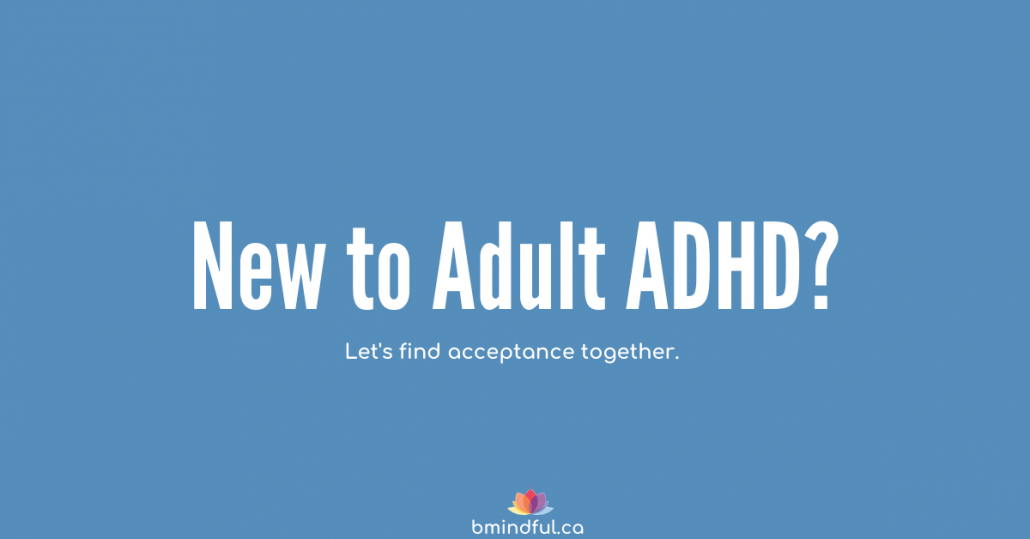 Being diagnosed (or realizing you may have ADHD) as an adult is most likely not a total shock, but with it can come a cascade of emotions and questions. A new diagnosis can begin a serious unravelling of your life’s narrative.
Being diagnosed (or realizing you may have ADHD) as an adult is most likely not a total shock, but with it can come a cascade of emotions and questions. A new diagnosis can begin a serious unravelling of your life’s narrative.
Seriously, why has it taken this long?
You may be wondering or even angry, why has it taken this long? No, it is not your parent’s fault (as easy as it would be to blame them). The ADHD diagnosis has taken a long ways to arrive at the understanding we have today. There has been a lot of misinformation and stigma surrounding ADHD that may have led our parents (or ourselves) back in the day, not pursue diagnosis. Further, if you are female there is another hurdle that ADHD was commonly seen as a condition that affects mostly males. Females often tend to have a less obvious type than males, and frequently ADHD symptoms might have been seen as “personality traits” (like being talkative).
Why now? Being diagnosed as adult often comes about when you become a parent. ADHD has long been identified as a common disorder of childhood. In fact, ADHD was not fully recognized as a condition that persists into adulthood until about 20 years ago. It is in becoming a parent that starts this unfolding process. Primarily because through the process of a child being diagnosed, one learns the condition is hereditary, with a 40 % chance that one or both parents has ADHD as well. If it is not from becoming a parent, it may be from some other huge life change, a separation in a relationship, a new job, you know those huge curve balls mid-life likes to throw. Until this point, your amazing brain has learnt along the way how to compensate for wiring challenges, however a new change may just put you over your capacity to manage things the way your previously were able to.
A new ADHD diagnosis comes with a mixed bag of emotions
Now, let’s take a slow deep breath together. Being diagnosed (or becoming aware) as an adult can alter the entire way you have seen your life. It may come with a sense of relief at finally understanding why you are the way they are. It may also be joined by anger, sadness, or regret for past struggles. You may be rethinking how things might have been different if you had only known sooner. A new diagnosis can begin a serious unravelling of life events that may lead to you seeing people and memories in different ways. This is a normal part of the journey, know that you are not the first (or last) ADHD adult to be experiencing these waves.
The journey of getting the right help
You may have noticed you have more challenges than other adults when it comes to organization, focus, time-management and motivation. Luckily, you do not have to continue life as usual or go it alone. Know that research has shown that ADHD responds successfully with a combination of medication and therapy. Boom, quality of life will be enhanced! This life altering moment is truly an opportunity, but it may take time to find the right medication, the right fit with professional help, and/ or alternative supports, like books, blogs, and groups that really get ‘you’. [Insert patience here].
So it’s not me, it just that my brain is wired differently?
Awareness of your newfound ADHD can often bring seismic shifts. It is essential to gain an understanding of the effects of ADHD and learn new skills to make up for these executive function deficits. Understanding the ways your brain functions differently, how it has impacted your life growing up and how it is affecting you today can truly make a different in your daily perspective. However, know that there is no instant trick or cure. This is a marathon not a sprint. It is not just about learning new skills, but more so about learning how to implement them day, after day, after day. This my friend, requires solid acceptance. It is a difficult process and journey, but with it may come a new self-understanding, forgiveness, ease of being with others, and ultimately feeling good about yourself (because you are pretty spectacular).
Stay tuned as we dive deeper into what self-acceptance really looks like for ADHD and how you can change your relationship with your (big beautiful) ADHD brain.
What is an ADHD coach? Could it change my life that much? Is it worth my investment of time and money? Will I really learn to follow through with my commitments?
Yes, yes, and yes.
Many of us instinctively know the benefits and calming effects of nature on our physical and mental health. The last time you spent an afternoon hiking, or taken a stroll in a community park, you may have noticed upon your return to home that you were more focused, less depleted and in a better mood. This is not surprising since research shows that outdoor activities appear to have significant health benefits that continue after our time in nature (Barton & Pretty, 2010).
Most of our daily activities such as work, homework, driving, planning our day, making lists, etc. require focused and directed attention that can lead to mental fatigue. According to Kaplan’s (1995) research on Attention Restorative Theory (ART), being in natural environments or participating in activities that require an involuntary form of attention (e.g. captivating, gentle fascination), effortless curiosity, and a sense of escape will have restorative effects on the mind and promote overall wellbeing.
More importantly, research shows that children with ADHD who spend time in nature show reduced symptoms associated with impulsivity, attention and concentration (Kuo & Taylor, 2004). Green-time appears to promote long-term effects on these executive function domains, and therefore impacting functions related to academic, work, and relationship success. As if this was not enough… being outdoors also promotes an opportunity to engage in unstructured activities, increase communication, and social connectedness (Kuo et al., 1998).
Accordingly, spending time in nature is a solid investment in our wellbeing! In Ottawa, we are lucky to be surrounded by the Greenbelt and Gatineau Park, so nature is really not that far away! Green-time exercises can include: gardening, finding a calm location at a park and sitting for 20 minutes without access to technology, recording in a journal about seasonal changes, hike on a nature trail, visiting the Arboretum or the gardens at the Horticultural Museum, collecting wild flowers, leaves, pine cones or rocks and bringing them home for an art project.
While green-time improves attention, and mitigates symptoms of ADHD, it should be used as a supplemental approach to conventional and evidence-based treatment interventions which we provide at Bmindful Psychotherapy and Coaching Centre.
Online Resources:
Child and Nature Network: http://www.childrenandnature.org/
Mood Walks: http://www.moodwalks.ca/about-mood-walks/the-nurture-of-nature-natural-settings-and-their-mental-health-benefits/
Green Cities: Good Health: http://depts.washington.edu/hhwb/Thm_Mental.html
References:
Barton, J., & Pretty, J. (2010). What is the best dose of nature and green exercise for improving mental health? A multi-study analysis. Environmental Science and Technology, 44, 3947-3955.
Kaplan, S. (1995). The restorative benefits of nature: toward an integrative framework. Journal of Environmental Psychology, 15, 169-182.
Kuo, F. E., & Taylor, F. A. (2004). A potential natural treatment for attention-deficit/hyperactivity disorder: evidence from a national study. American Journal of Public Health, 94(9), 1580-1586.
Kuo, F. E., Sullivan, W. C., & Coley, R. L. (1998). Fertile ground for community: inner-city neighborhood common spaces. American Journal of Community Psychology, 26, 823-851.
Information about ADHD is widely available on the net. We have found the following information worthy of sharing with you:
Canadian Government ADHD Information
Center for ADHD Awareness
Mental Health Canada: ADHD

